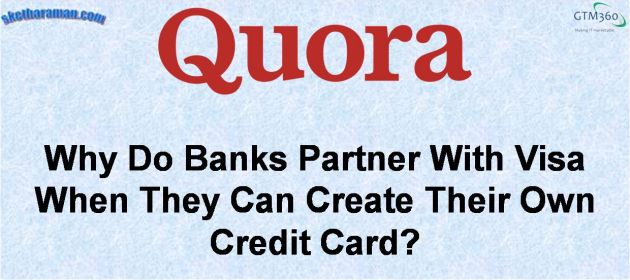(This post is a slightly edited version of my answer to the above Quora question.)
Banks have created a plethora of products like checking account, savings account, mortgage, High Frequency Trading, Structured Finance Products, and so on. What’s one more? Therefore, the OP’s question prima facie makes a lot of sense.
In fact, back in the day, many banks did create their own credit card. For example, the first credit card I had was created and issued by a public sector bank headquartered in Bangalore. It was not a Visa or MasterCard. It’s an example of what’s called “Closed Loop” credit card.
The challenge in that model is that, each bank has to go out and sign up merchants to accept its credit card aka “acquire” in the industry parlance. Acquiring costs a lot of time and money. It’s difficult to achieve significant scale. If enough merchants don’t accept the bank’s credit card, the bank will find it hard to get enough consumers interested in buying its credit card. If enough consumers don’t buy its credit card, the bank will find it hard to get enough merchants to accept its credit card. This creates a vicious cycle and imposes a severe constraint on scaling up of a bank’s credit card business. I witnessed this first hand with my aforementioned closed loop credit card. It had decent acceptance in Bangalore and other cities in South India but not so much in Bombay, Pune, and other cities in West India.
To solve this pain, banks got together and created a card network. They way this network worked, a merchant acquired by any one bank on this network would automatically accept the credit cards issued by all banks on the network. These credit cards are known as “Open Loop”. The operating model of open loop credit card generated a force-multiplier effect and helped the network go global. As a result, a supermarket in Timbuktu would accept a credit card issued by a bank in Bangalore without knowing the bank (or even Bangalore!). This ensured that credit cards of this network enjoyed a wider acceptance compared to closed loop credit cards of individual banks. This in turn drove more consumers to buy one. As more people got credit cards, more merchants signed up to accept credit cards. This created the so-called “Network Effect” and led to an explosion of scale for the credit card business.
This card network’s name is Visa.
Today, there are 20 billion Visa credit cards globally. I doubt if any other product has a wider global acceptance than credit card.
For providing the network service, the issuer and acquirer banks paid a fee to Visa. But, since Visa was jointly owned by many of these same banks, money was really going out of one pocket and coming back to another pocket.
While Visa later became an independent publicly traded company, member banks still own a significant chunk of equity in Visa and therefore earn mouthwatering dividends from them.
Furthermore, there are many other ways in which banks make money from the credit card business, as I highlighted in my blog post titled How Do Banks Make Money From Credit Card Business?.
PSA for Faux Patriots: Visa / MasterCard don’t earn ₹2 on every ₹100 credit card transaction in India. They earn only ₹0.25. The other ₹1.75 is earned by banks in India who pay tax due on it to Indian govt, India benefits. OTOH, banks in India make ₹0 on a typical ₹100 UPI…
— Ketharaman Swaminathan (@s_ketharaman) September 17, 2023
As a result, even after paying a rake to Visa, credit card is the most profitable business for many retail banks.
MasterCard came shortly after.
Given how well the partnership with Visa (and MasterCard) has worked out for banks, it doesn’t make much sense for them to create their own credit card.
That said, there’s still one bank that does issue its own credit card and acquire merchants by itself, thus getting to keep the entire interchange revenue for itself. That bank is American Express. While AmEx doesn’t have as much market share as Visa / MasterCard, it’s a big enough company in its own right and is reported to be more profitable.
PS: The expression in the original question is “issue their own credit card”. I changed it to “create their own credit card” in order to avoid confusion with the activity of banks of giving out Visa / MasterCard credit cards, which is called “issuing” in the industry jargon.
Related reading:
